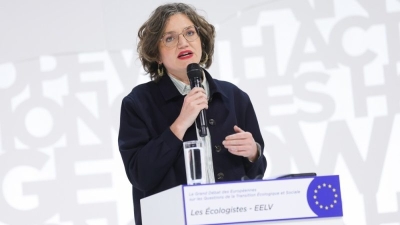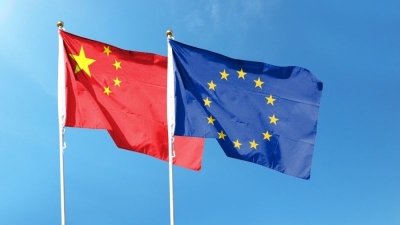Nuclear fusion can help Europe achieve net-zero goal, EU official says

Nuclear fusion, which replicates the sun’s energy production, is a carbon-free technology that could help secure Europe’s energy supply and slash its emissions, according to European Commission official Massimo Garribba.
“In the Commission, we follow a net-zero policy and so each and every energy source that can contribute to that is, of course, most welcome,” said Garribba, who is deputy director general at the Commission’s energy department.
And according to Garribba, nuclear fusion “is clearly a candidate in the medium term to fit this role”.
This is because fusion is carbon-free, safe and “has the potential to be rather limitless in the way that it can be exploited,” the EU official told participants at a EURACTIV event on Monday (20 March).
Nuclear fusion replicates energy production in the sun, fusing two hydrogen atoms to produce helium and heat. It could be a way to generate large amounts of clean energy, helping to replace fossil fuels and reduce emissions.
However, the technology is still being developed with current barriers, including the huge amount of energy required for the reaction to take place. Once it reaches a stage where more energy is produced than is used, it could become a key energy source for Europe.
“It’s a reaction that is controllable. It can be turned on and off, so it makes an ideal dispatchable power source and it can serve as a baseload source of power,” said Jennifer Ganten, chief movement builder at the Commonwealth Fusion System.
While a lot of work is needed to develop nuclear fusion, some projects are expected to have operating models by the middle of this decade, with the first reactors potentially connecting to the grid at the beginning of the 2030s.
“Then there’ll be a ramp up, of course, so we think the technology would be ready for commercial use by the mid-2030s,” said Francesca Ferrazza, the head of magnetic fusion initiatives at Eni, the Italian energy company, which supported the event.
“If the conditions continue, with the technology evolving and the supply chain coming into place and everything else and it goes at scale, it will make a significant contribution to decarbonisation, to 2050 goals,” Ferrazza added.
Fusion would support the EU’s climate targets, but it is also a “no-brainer” when it comes to energy security, according to Garribba.
Fusion requires two fuel sources, he explained: a Hydrogen isotope called deuterium, which is commonly found in water, and another isotope called tritium, currently produced in some nuclear fission reactions. This second isotope would ultimately be regenerated by the fusion process.
“If this is done, then you will have a cycle which is basically self-sustaining. In terms of energy security, this is a very advantageous situation,” explained Garribba.
Competition vs cooperation
Since the mid-1980s, world nations have been cooperating to develop nuclear fusion technology. This includes the International Thermonuclear Experimental Reactor (ITER), an international project funded by 35 partner countries, including the European Union, the UK, Switzerland, China, India, Japan, Korea, Russia, and the US.
The EU is part of the consortium working on the project, which aims to have an operational reactor in France by 2035.

ITER nuclear fusion reactor hit by COVID delay, rising costs
The International Thermonuclear Experimental Reactor (ITER) currently under construction in Cadarache, Southern France, will see cost overruns and delays due to the disruption caused by the COVID-19 pandemic, its top official said on Friday (17 September).
But other projects are now overtaking ITER, including the SPARC project in the US, one of several expected to be operational and achieve a net gain of energy in the mid-2020s. The project then aims to be commercially viable by the mid-2030s.
The EU needs to up its game in attracting fusion projects in the EU, according to Ondřej Knotek, a European Parliament lawmaker from the Czech Republic. He warned participants at the event that the EU does not support fusion enough to avoid losing out to the US and the UK.
“Now the priority is going to renewables, which I do understand in the short-term, but if we look into the longer perspective, then we simply need to have additional sources of energy,” he said.
“Those that are currently in development, like fusion, need our full recognition and this is what unfortunately we do not see today,” Knotek added, saying that the EU needs to find ways of promoting private investment in the sector.
Garribba disagreed that the EU is falling behind, saying that Europe has been “consistently leading in fusion research”.
But unlike the US’ Inflation Reduction Act, which has provisions for fusion, the EU’s newly proposed Net-Zero Industry Act only refers to fusion once and it is not counted as a ‘strategic net-zero technology’, limiting the amount of support available.
“When we prepare tools, communications, directives from Brussels, in all different institutions, we do not speak about fusion as something that will definitely be there and will definitely be part of the solution,” said Knotek.
Promoting regulatory certainty
The industry says that in order to attract projects, governments need to ensure the future laws that will govern fusion energy production are clear and that companies developing the technology have access to funding.
For instance, the UK is “leading the way” in thinking about the regulatory environment needed for fusion, said Ganten. “That means regulatory certainty – that matters, that attracts the commercial industry to say ‘this is a place we would want to look to build power plants’,” she explained.
This, according to Ganten, is key for companies looking to build projects, which need to find locations now to be operational in the early 2030s.
“This is the right time for Europe to be thinking about that regulatory certainty for the commercial sector in the 2030s, as well as any policies that would help fusion on a level playing field with other clean energy,” she said.
According to Garribba, the European Commission is in the early stages of reflecting on whether the EU should begin further work on improving the regulatory clarity for fusion.
“If we want to give regulatory certainty, we need to have a set of rules, which then cannot be changed. But we are at the prototype phase, so it’s very difficult to fully see how you can make rules which are generic enough, and at the same time, detailed enough to allow the development of different types of technologies,” he said.
> Watch the full recording of the event below:



